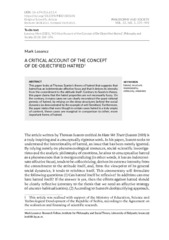A Critical Account of the Concept of De-Objectified Hatred
Kritički osvrt na koncept deobjektifikovane mržnje
Članak u časopisu (Objavljena verzija)
Metapodaci
Prikaz svih podataka o dokumentuApstrakt
This paper looks at Thomas Szanto’s theory of hatred that suggests that hatred has an indeterminate affective focus and that it derives its intensity from the commitment to the attitude itself. Contrary to Szanto’s theses, this paper claims that the hated properties are not necessarily fuzzy. On the contrary, in many cases we can clearly reconstruct the quasi-rational genesis of hatred, by relying on the deep structures behind the social dynamics (as demonstrated by the example of anti-Semitism). Furthermore, the paper states that even though in certain cases hatred is a truly empty of content, these cases are marginal in comparison to other, more important forms of hatred.
Članak se fokusira na teoriju mržnje kod Tomasa Santa koja sugeriuše da mržnja nema jasan
afektivni fokus, te da njen intentizet proističe iz zalaganja za sam intencionalni stav mržnje.
Za razliku od Santove teze, članak trvrdi da omražena svojstva nisu nužno nejasna. Naprotiv,
u mnogim slučajevim se precizno može rekonstruisati kvazi-racionalna geneza mržnje, oslanjajući se na duboke strukture iza društvene dinamike (kao što pokazuje primer antisemitizma). Nadalje, članak konstatuje da iako je istina da je u izvesnim slučjavima mržnja bez sadržaja, ovi slučajevi su marginalni u odnosu na druge, značajnije forme mržnje
Ključne reči:
hatred / structure / intentionality / reflexivity / emotionsIzvor:
Filozofija i društvo/Philosophy and Society, 2021, 32, 3, 369-376Izdavač:
- Beograd : Institut za filozofiju i društvenu teoriju
Finansiranje / projekti:
- Ministarstvo nauke, tehnološkog razvoja i inovacija Republike Srbije, institucionalno finansiranje - 200025 (Univerzitet u Beogradu, Institut za filozofiju i društvenu teoriju) (RS-MESTD-inst-2020-200025)
Institucija/grupa
IFDTTY - JOUR AU - Losoncz, Mark PY - 2021 UR - http://rifdt.instifdt.bg.ac.rs/123456789/2273 AB - This paper looks at Thomas Szanto’s theory of hatred that suggests that hatred has an indeterminate affective focus and that it derives its intensity from the commitment to the attitude itself. Contrary to Szanto’s theses, this paper claims that the hated properties are not necessarily fuzzy. On the contrary, in many cases we can clearly reconstruct the quasi-rational genesis of hatred, by relying on the deep structures behind the social dynamics (as demonstrated by the example of anti-Semitism). Furthermore, the paper states that even though in certain cases hatred is a truly empty of content, these cases are marginal in comparison to other, more important forms of hatred. AB - Članak se fokusira na teoriju mržnje kod Tomasa Santa koja sugeriuše da mržnja nema jasan afektivni fokus, te da njen intentizet proističe iz zalaganja za sam intencionalni stav mržnje. Za razliku od Santove teze, članak trvrdi da omražena svojstva nisu nužno nejasna. Naprotiv, u mnogim slučajevim se precizno može rekonstruisati kvazi-racionalna geneza mržnje, oslanjajući se na duboke strukture iza društvene dinamike (kao što pokazuje primer antisemitizma). Nadalje, članak konstatuje da iako je istina da je u izvesnim slučjavima mržnja bez sadržaja, ovi slučajevi su marginalni u odnosu na druge, značajnije forme mržnje PB - Beograd : Institut za filozofiju i društvenu teoriju T2 - Filozofija i društvo/Philosophy and Society T1 - A Critical Account of the Concept of De-Objectified Hatred T1 - Kritički osvrt na koncept deobjektifikovane mržnje IS - 3 VL - 32 SP - 369 EP - 376 DO - 10.2298/FID2103369L ER -
@article{
author = "Losoncz, Mark",
year = "2021",
abstract = "This paper looks at Thomas Szanto’s theory of hatred that suggests that hatred has an indeterminate affective focus and that it derives its intensity from the commitment to the attitude itself. Contrary to Szanto’s theses, this paper claims that the hated properties are not necessarily fuzzy. On the contrary, in many cases we can clearly reconstruct the quasi-rational genesis of hatred, by relying on the deep structures behind the social dynamics (as demonstrated by the example of anti-Semitism). Furthermore, the paper states that even though in certain cases hatred is a truly empty of content, these cases are marginal in comparison to other, more important forms of hatred., Članak se fokusira na teoriju mržnje kod Tomasa Santa koja sugeriuše da mržnja nema jasan
afektivni fokus, te da njen intentizet proističe iz zalaganja za sam intencionalni stav mržnje.
Za razliku od Santove teze, članak trvrdi da omražena svojstva nisu nužno nejasna. Naprotiv,
u mnogim slučajevim se precizno može rekonstruisati kvazi-racionalna geneza mržnje, oslanjajući se na duboke strukture iza društvene dinamike (kao što pokazuje primer antisemitizma). Nadalje, članak konstatuje da iako je istina da je u izvesnim slučjavima mržnja bez sadržaja, ovi slučajevi su marginalni u odnosu na druge, značajnije forme mržnje",
publisher = "Beograd : Institut za filozofiju i društvenu teoriju",
journal = "Filozofija i društvo/Philosophy and Society",
title = "A Critical Account of the Concept of De-Objectified Hatred, Kritički osvrt na koncept deobjektifikovane mržnje",
number = "3",
volume = "32",
pages = "369-376",
doi = "10.2298/FID2103369L"
}
Losoncz, M.. (2021). A Critical Account of the Concept of De-Objectified Hatred. in Filozofija i društvo/Philosophy and Society Beograd : Institut za filozofiju i društvenu teoriju., 32(3), 369-376. https://doi.org/10.2298/FID2103369L
Losoncz M. A Critical Account of the Concept of De-Objectified Hatred. in Filozofija i društvo/Philosophy and Society. 2021;32(3):369-376. doi:10.2298/FID2103369L .
Losoncz, Mark, "A Critical Account of the Concept of De-Objectified Hatred" in Filozofija i društvo/Philosophy and Society, 32, no. 3 (2021):369-376, https://doi.org/10.2298/FID2103369L . .



